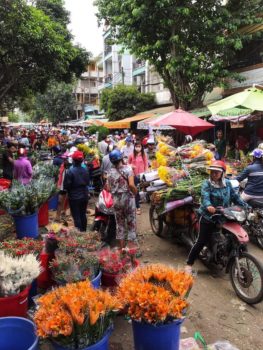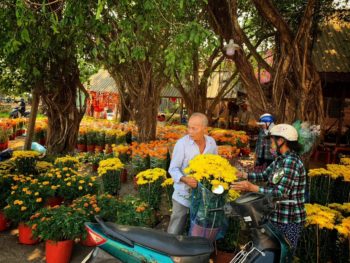Vietnamese Lunar New Year Customs Posted by Kandle Dart on Feb 1, 2021 in Culture, Vocabulary
Chúc Mừng Năm Mới! (Happy New Year)

Photo taken and used with permission from Duong Ky Lam
The most important, longest, and biggest festival in the year for the Vietnamese is Tết Nguyên Đán (Vietnamese Lunar New Year Celebration), also called Tết Âm Lịch, Tết Ta, Tết Việt Nam, or simply Tết, which lasts for at least a week to even a month long. For 2021, Tết Nguyên Đán will fall on Friday February 12, the year of Tân Sửu (year of the ox). This year, the Vietnamese Prime Minister officially approved a seven day holiday for everyone, students and workers, from February 10 to February 16. However, each locality and business may extend it longer, ten to fourteen days.
There are a lot of traditions and customs on Tết. Below are just a few of the “pre-Tết” ones that you may find interesting.
Kitchen God’s Farewell Day
Preparation for the Tết celebration started on the 23rd day of the twelfth lunar month (February 4), which is Ông Táo (Kitchen God)’s farewell day. It’s a common belief that at the end of every year Ông Táo returns to heaven to report to Ngọc Hoàng (Jade Emperor) the deeds of each household through the preceding year. Ông Táo knows all the family secrets, since he has spent the whole year in the kitchen. A sumptuous food offering is traditionally placed on Ông Táo’s altar on this day to fare him well before his journey to heaven. It’s also a subtle bribe, so that Ông Táo will give a favorable report to Ngọc Hoàng. Many Tết cultural activities often include a comedy act depicting Ông Táo reading reports of local social and economic events for entertainment.
Cleanup & Decorations
To resolve the bad luck from the “old year” and to encourage good luck for the “new year”, houses are often thoroughly cleaned. Bronze items on the altar, such as candle holders, incense burners, and vases are polished to a shine. The main altar decoration is an important focal point for the Vietnamese on Tết. Mâm ngũ quả (a platter of five fruits), a pair of trái dưa hấu (watermelon), a pair of bánh chưng (steamed sticky rice cake wrapped in banana leaves), and a pair of vases filled with fresh flowers are traditionally placed there. Hanging on both sides of the main altar, or by the entrance door, you may find a câu đối (distich) written on red paper. The câu đối is both decorative and an inspiring or heartwarming saying. Right by the main house or business entrance, people often showcase exotic plants or traditional flowers in an artistic shape.
Tết Markets
A few weeks before the new year, chợ Tết (Tết markets) pop up everywhere. Most notable are chợ hoa (flower markets), gian hàng trái cây (fruit shops), and gian hàng bánh mứt (sweet treats & fruit candies). The traditional and must have flower for Tết is Hoa Mai (yellow Mai flower) or Hoa Đào (peach blossom). Other popular varieties found at chợ hoa include chrysanthemum, marigold, zinnia, and the kumquat plant.
Since local markets are closed during the Tết celebration, rice, salt, fish sauce, and other groceries are fully stocked in the kitchen. On top of that, every family makes some traditional holiday foods for Tết. Needless to say, chợ Tết is bustling with people!
Tết Gifts
Tết is an occasion to bring gifts to parents, relatives, teachers, bosses, friends, or whomever one wishes to express gratitude and respect. The items given are usually traditional foods, sweet treats, special snacks, wine bottles, or fresh potted plants. These gifts are given before New Year’s Day.
Visiting Ancestor’s Graves
During the week of Tết, it’s customary that the descendants of the family visit their elders or the graves of their deceased family members to clean, burn incense, and pray to the deceased.

Build vocabulary, practice pronunciation, and more with Transparent Language Online. Available anytime, anywhere, on any device.




